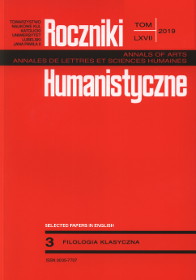“Est locus, aestifero” (Carm. 1.18) as an Example of the Locus Amoenus Topos in the Poetry of Venantius Fortunatus
Abstract
The Polish version of the article was published in Roczniki Humanistyczne vol. 61, issue 3 (2013).
In this article the author presents the poem “Est locus, aestifero,” which appeared in the first book of Carmina, against the background of the topic of locus amoenus in the poetry of Venantius Fortunatus. The poem has 18 lines and is written in elegiac meter. It is a description of the village (country estate) of Bissonum, near Bordeaux. The ekphrasis, into which are woven the elements of the topic we are interested in, is combined with a very clear motif of laudation. This is a characteristic feature of Venantius Fortunatus’ poetry. The English translation of the poem is an integral part of the essay.
References
Auerbach, Erich. Język literacki i jego odbiorcy w późnym antyku łacińskim i średniowieczu [Literary language and its audience in late Latin antiquity and in the Middle Ages]. Translated by Robert Urbański. Cracow: Homini, 2006.
Cassingena-Trévedy, François. “Son et lumière, la « matière » liturgique des Carmina de Venance Fortunat: entre l’adventus de la croix et l’icône de Martin de Tours,” Camenae 11 (2012) (Présence et visages de Venance Fortunat XIVe centenaire). http://www.paris-sorbonne.fr/IMG/pdf/6Cassingena_Camenae.pdf.
Curtius, Ernst Robert. Literatura europejska i łacińskie średniowiecze [European literature and the Latin Middle Ages]. Translated and edited by Andrzej Borowski. Cracow: Universitas, 19972.
Cytowska, Maria. “Ostatni poeta starożytności—Wenancjusz Fortunatus” [The last poet of antiquity—Venantius Fortunatus]. Meander 28, no. 7–8 (1973): 307–320.
Fortunatus, Venantius. Poems, edited and translated by M. Roberts. Cambridge, MA 2017.
Gacia, Tadeusz. “Motyw krzyża w twórczości Wenancjusza Fortunata na przykładzie Vexilla Regis” [The motif of the cross in the works of Venantius Fortunatus as exemplified by Vexilla Regis]. Roczniki Humanistyczne 46, no. 3 (1998): 101–112.
Gacia, Tadeusz. “Topos locus amoenus w łacińskiej poezji chrześcijańskiego antyku” [The topos of locus amoenus in the Latin poetry of Christian antiquity]. Vox Patrum 28, vol. 12 (2008): 187–198.
Gacia, Tadeusz. Wenancjusz Fortunat. Poezje (Wybór). translated from Latin, preceded by an introduction and provided explanations by rev. Tadeusz Gacia. Lublin: TN KUL, 2018.
Gacia, Tadeusz. ‘Vernalia tempora mundo...’ Wenancjusz Fortunat i jego poezje liryczne. Lublin: Jedność, 2014.
Navarra, Leandro. “Venanzio Fortunato.” In Nuovo dizionario patristico e di antichità cristiane, vol. 2, 3556–3558. Rome, Italy: Marietti, 2006.
Niewiadomska, Magdalena. “Wiersze o Krzyżu Wenancjusza Fortunata. Próba interpretacji” [Venantius Fortunatus’ poems about the Cross: An attempt at interpretation]. Przegląd Tomistyczny 9 (2003): 281–310.
Rolet, Anne. “L’Arcadie chrétienne de Venance Fortunat. Un projet culturel, spirituel et social dans la Gaule mérovingienne.” Médiévales 15, No 31 (1996): 109–127.
Copyright (c) 2019 Roczniki Humanistyczne

This work is licensed under a Creative Commons Attribution-NonCommercial-NoDerivatives 4.0 International License.





